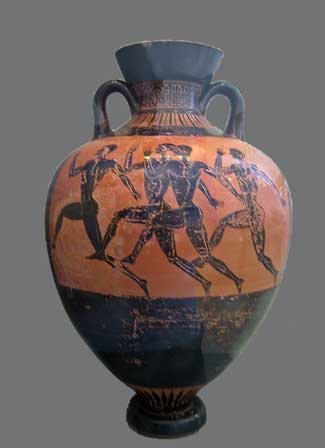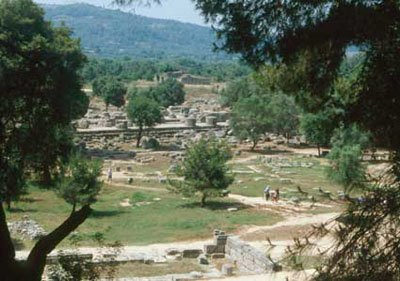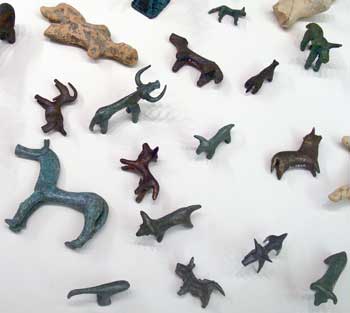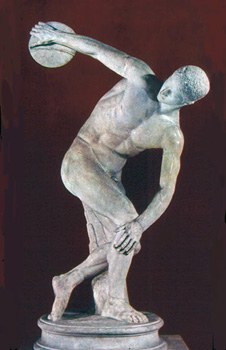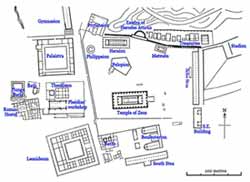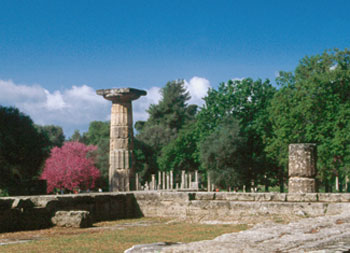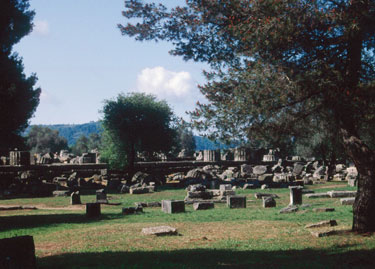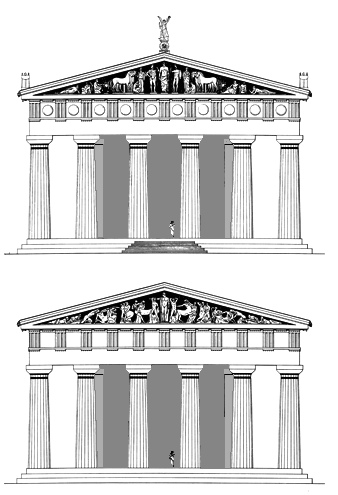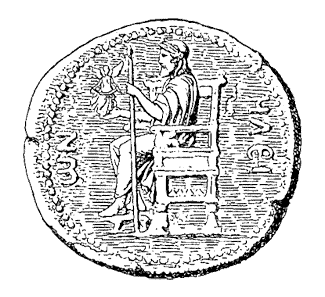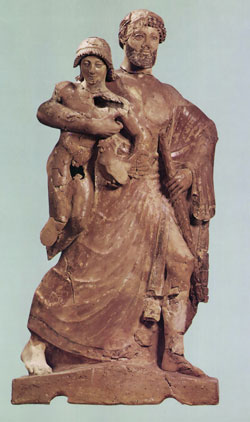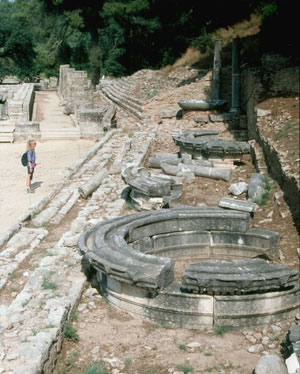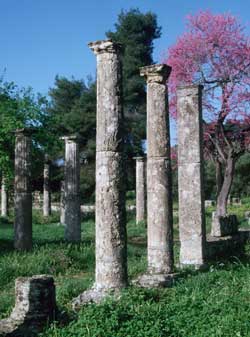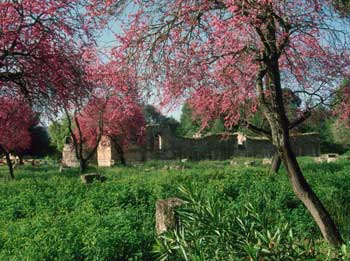
The traditional date for the first Olympic Games is 776 BC, calculated by the ancient Greeks themselves by using a list of winners, but there was almost certainly activity at the site of Olympia before that. The Greeks had only been literate since the eighth century BC, so the names of earlier winners may well have been forgotten. In historical times, control over the games was disputed between the town of Elis and the town(?) of Pisa. This may explain the fact that there are two different foundation legends. According to one version the games commemorated a footrace held by the Idaean Herakles and his brothers with a branch cut from a grove wild olive trees at the site. 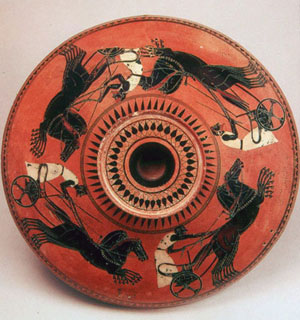 However, most people believed that they were begun by the mythological hero Pelops after whom the Peloponnese (“Pelop's island”) was named. Like most Greek heroes, he came from a dysfunctional family— his father, Tantalus, once cooked him up and served him to the gods to see if they could tell the difference between human and animal flesh (they could). His lover was the god Poseidon who was associated with horses as well as the sea. Through him, Pelops had a team of the finest horses and had acquired great skill as a driver. When he grew up, he began to court Hippodameia, the daughter of Oenomaos of Pisa. The king had an incestuous passion for his daughter, according to some, and let it be known that, while anyone was free to carry her off, he would pursue and slay the hapless suitor if he could. Thirteen of them had already perished when Pelops arrived on the scene. He bribed Oenomaos' charioteer to sabotage the vehicle so that his master was thrown and killed. Pelops married Hippodameia and ruled the land quite happily for a time (although that didn't last). After his death, a shrine was built for him within the precinct and funeral games were instituted in his honour.
However, most people believed that they were begun by the mythological hero Pelops after whom the Peloponnese (“Pelop's island”) was named. Like most Greek heroes, he came from a dysfunctional family— his father, Tantalus, once cooked him up and served him to the gods to see if they could tell the difference between human and animal flesh (they could). His lover was the god Poseidon who was associated with horses as well as the sea. Through him, Pelops had a team of the finest horses and had acquired great skill as a driver. When he grew up, he began to court Hippodameia, the daughter of Oenomaos of Pisa. The king had an incestuous passion for his daughter, according to some, and let it be known that, while anyone was free to carry her off, he would pursue and slay the hapless suitor if he could. Thirteen of them had already perished when Pelops arrived on the scene. He bribed Oenomaos' charioteer to sabotage the vehicle so that his master was thrown and killed. Pelops married Hippodameia and ruled the land quite happily for a time (although that didn't last). After his death, a shrine was built for him within the precinct and funeral games were instituted in his honour.

Map. Greek Sanctuaries
The site is located on a particularly lovely, fertile tract of land in the north-western Peloponnese at the junction of the Alphaos and Kladeos Rivers. It is dominated by a high conical hill, the kronion (“Hill of Kronos”). Traces of a Bronze Age settlement have been bound on the southern slopes of the Kronion, with material dating back to the Early Helladic Period (third millennium BC). There is some evidence of cult activity as early as the Late Bronze Age, the time of Mycenaean civilization, but the site doesn't really “take off” until the Geometric period, the 10th-8th century BC— the period in which the games were said to have been founded. Hundreds of votive objects, including large numbers of small bronze figures of men and horses, have been recovered from the site.
The Games
The games were held every four years, beginning on the second or third full moon after the summer solstice— so, sometime in late July or August. Originally, they lasted only one day and consisted of a single event, a footrace known as the stadion, but by 472 BC the competitions had been considerably expanded and the festival had been extended to five days. From the time of the seventh Olympiad (748 BC) onwards the prize was a kotinos, a garland of wild olive from a sacred tree which grew on the site. The branch was cut by a boy whose parents were still both living— evidently a fertility rite of some antiquity. The games were staged without interruption for almost twelve hundred years until they were abolished, along with all of the other pagan cults, by the emperor Theodosius in 393 BC.
The presiding officials, the ones who acted as judges and enforced the rules, were known as Hellanodikai and were chosen by lot from among all the citizens of Elis. They wore purple robes and lived in a special building, the Hellanodikeon, for the ten months leading up to the games. During this period they received instruction from the nomophylakes (“guardians of the games”) on their duties and the regulations they would have to enforce. As the games approached, a Sacred Truce was declared which put an end to all hostilities and the athletes along with various dignitaries and ordinary pilgrims began to converge on the site from all over the Greek World. Anyone could compete so long as their parents were freeborn and of pure Hellenic blood and they themselves were male— women were forbidden to so much as set foot in the precinct during the games on pain of death. During the first day, the athletes took part in a number of rituals and ceremonies including the taking of the Olympic Oath. The atheletic events, along with various religious rituals, took place over the next three days with the closing ceremonies on the morning of the final day. The winners were then awarded their prizes and given a banquet at a building known as the Prytaneion.
Over the years, the Games were expanded to include a wide variety of athletic competition. A double foot race over two stadia was added in 724 BC and a distance race four years later. The 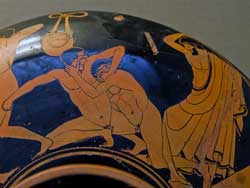 pentathlon— the discus, javelin, sprint wrestling and the long jump— made its debut in 708 BC along with wrestling and boxing. The first chariot race took place in 680 BC as did horse racing and an event known as the pankration (a
pentathlon— the discus, javelin, sprint wrestling and the long jump— made its debut in 708 BC along with wrestling and boxing. The first chariot race took place in 680 BC as did horse racing and an event known as the pankration (a  no-holds-barred combination of wrestling and boxing, right). The hoplitodromos, a race in full armour, was introduced in 520 BC. Events for boys were added in 632 BC andcontests for heralds and trumpeters in 396 BC. Apart from the equestrian events and the hoplitodromos, the athletes trainedand competed naked,offering their bodies to the glory of Zeus.
no-holds-barred combination of wrestling and boxing, right). The hoplitodromos, a race in full armour, was introduced in 520 BC. Events for boys were added in 632 BC andcontests for heralds and trumpeters in 396 BC. Apart from the equestrian events and the hoplitodromos, the athletes trainedand competed naked,offering their bodies to the glory of Zeus.
The victor of any Olympic competition was honoured throughout the Greek world but nowhere so much as in his home town where he received a hero's welcome. A short stretch of the town wall was demolished to show that its defence depended not so much on masonry as the superior quality of its young men. The winner was driven through the breach in a four-horse chariot and led the entire populace in a triumphal procession to the altar of the city god where he laid down his olive crown. A great banquet followed at which a chorus would sing a paeon of praise composed for the occasion. Poets such as Pindar or Simonides, made a good living out of writing these hymns of praise. For the rest of his life he would enjoy free meals at the prytaneion in his home town, reserved seats at the theatre, games and festivals as well as various tax-exemptions. Often a statue of him was set up in one of the temples to honour both the athlete and the gods who gave him victory. These votive statues are known as kouroi and were especially common in the Archaic Period that ended with the Persian invasions of the fifth century BC. One of the finest examples is the co-called Kritios boy (left), found on the Acropolis in Athens.
The Sanctuary
In the earliest years of the Games, the Altis (as the sacred enclosure was known) was empty of any permanent structures— apart from altars and heröa (hero shrines) of Pelops and Hippodameia. The area was surrounded by a peribolos (enclosure wall)— originally of wood but later of stone. Over the centuries, however, as the Games achieved international fame, a number of buildings were added both inside and outside the altis. Only cult buildings were permitted within the enclosure itself but secular structures crowded it on all four sides.
The Heraion
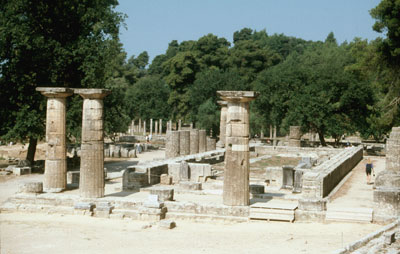 The Temple of Hera is the oldest surviving building on the site (it replaced an earlier version) and one of the most important and influential structures in the history of Greek architecture. It was built towards the end of the seventh century BC, at the foot of the Kronion. Like most Greek temples it faced east.
The Temple of Hera is the oldest surviving building on the site (it replaced an earlier version) and one of the most important and influential structures in the history of Greek architecture. It was built towards the end of the seventh century BC, at the foot of the Kronion. Like most Greek temples it faced east.
It was one of the first examples of the Doric Order on the Greek mainland and retained a number of earlier features. The platform and lower parts of the walls were built out of local limestone but the rest of the superstructure was of mud brick and the original columns were made out of wood. The latter were replaced (as necessary) with stone versions— a solitary wooden one was still standing as late as AD 173. The individual columns vary markedly in style and even in size (diameters vary by about a foot) which shows that they were put up at different times— presumably as individual acts of piety.
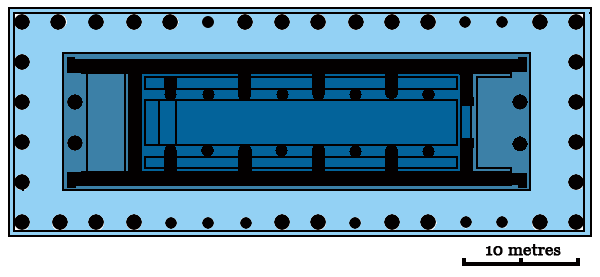
Plan of the Heraion
The cella was of the type known as a hecatompedon, meaning it was 100 Greek feet in length, and had porches at the front and rear, each with a pair of columns in antis. There are two rows of four columns running the length of the cella but the builders apparently did not trust the load-bearing capacity of these, so they alternated the columns with short partition walls creating a series of alcoves along each side.
The Pelopion
The Temple of Pelops was an open air shrine, which presumably included a sacred grove, dedicated to the founding hero and was located right next to the Hera Temple on the south side. It was enclosed by a perimeter wall which was circular at first but this was replaced by a polygonal one with an elaborate propylon (gatehouse) in the sixth century BC. Somewhere nearby, to the southeast of the Heraion, was the Great Altar of Zeus. No trace of it survives today— it was simply a huge mound of ashes, the residue of countless sacrifices over the course of more than a thousand years.
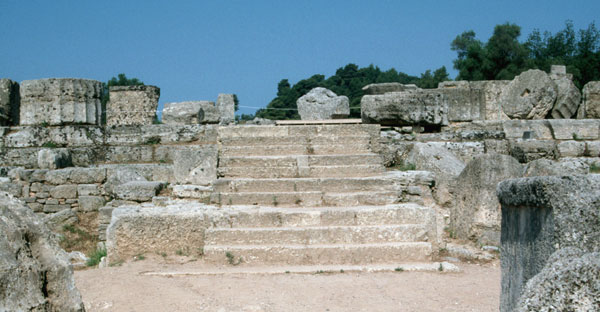
Entrance to the Temple of Zeus
The Temple of Zeus
The principal temple in the sanctuary was not built until long after the Heraion went up. By the middle of the fifth century BC, the Sanctuary had reached new heights of wealth and importance. The building was 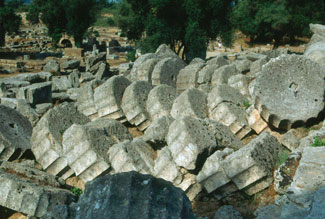 designed by the Elean architect, Libon, and was considered one of the outstanding achievements of the Doric order— so much so that many later temples were modelled after it. Unfortunately, due to earthquake activity, nothing much of the superstructure of the building remains standing. The tumbled remains of the columns lay next to it looking like rows of Oreo cookies (left). Much of the decoration of the temple has survived, broken into pieces where they fell to the ground. The east pediment was decorated with a frieze depicting the start of the chariot race between Pelops and Oenomaos with Zeus presiding while the western one shows the battle that broke out between the Lapiths and the Centaurs at the wedding of Peirithous and Deidameia. The metopes, the panels which ran above the columns along the sides of the temple, bore reliefs depicting the Twelve Labours of Herakles.
designed by the Elean architect, Libon, and was considered one of the outstanding achievements of the Doric order— so much so that many later temples were modelled after it. Unfortunately, due to earthquake activity, nothing much of the superstructure of the building remains standing. The tumbled remains of the columns lay next to it looking like rows of Oreo cookies (left). Much of the decoration of the temple has survived, broken into pieces where they fell to the ground. The east pediment was decorated with a frieze depicting the start of the chariot race between Pelops and Oenomaos with Zeus presiding while the western one shows the battle that broke out between the Lapiths and the Centaurs at the wedding of Peirithous and Deidameia. The metopes, the panels which ran above the columns along the sides of the temple, bore reliefs depicting the Twelve Labours of Herakles.
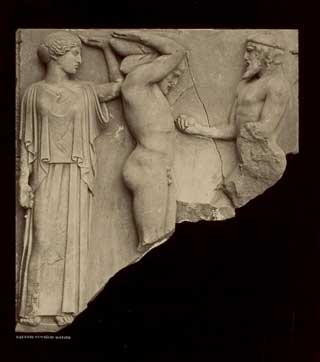
|

|
A statue of Nike, the winged goddess of victory, once crowned the the apex of the east pediment. Sculpted by Paionios, from Mende in the Chalkidike, it was a thank-offering presented by the Messenians and Naupactians, probably in 421 BC, out of the spoils of their victory over the Spartans in the Archidamean War.
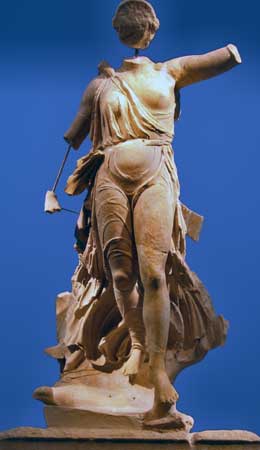 Nike by Paionios (as recovered) Nike by Paionios (as recovered) |
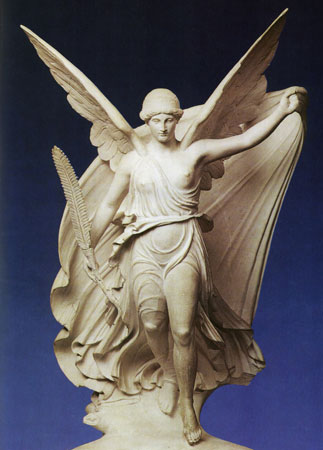 Nike by Paionios (restored) Nike by Paionios (restored) |
Inside the temple was one of the seven wonders of the ancient world, a colossal statue by the Athenian sculptor Pheidias of Zeus seated on his throne, which was installed in 430 BC. It was chryselephantine, meaning that it was made out 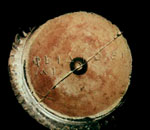 of ivory (for the exposed flesh) and gold for the rest. Not a scrap of it survives but there is a detailed description by Pausanias (author of an ancient travel guide to Greece) and some bad reproductions on Elean coins. Pheidias' workshop is just outside the western boundary of the sanctuary where a kylix (wine cup) with his name scratched on the bottom has been found (left).
of ivory (for the exposed flesh) and gold for the rest. Not a scrap of it survives but there is a detailed description by Pausanias (author of an ancient travel guide to Greece) and some bad reproductions on Elean coins. Pheidias' workshop is just outside the western boundary of the sanctuary where a kylix (wine cup) with his name scratched on the bottom has been found (left).
One notable sculpture that did survive is a baked clay statue depicting the abduction of Ganymede (right), a young Trojan prince, by the god Zeus to serve as his cupbearer as well as his catamite. Normally, because of their lightness, terracotta sculpture was used to ornament temple buildings but, in this case, the consensus among scholars is that it was a votive offering. The ancient Greeks would not have been even slightly shocked by the subject matter and the younth himself seems more bemused than alarmed— he is shown holding a cockerel, typically a lover's gift. It probably dates to the early decades of the fifth century BC.
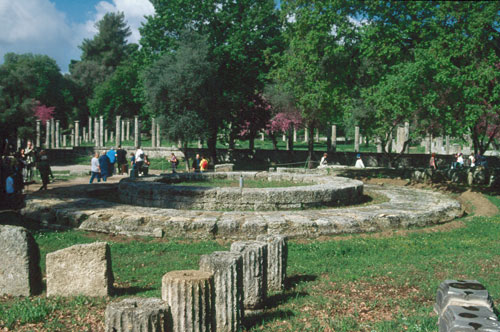
The Philippeion (since this photo was taken, part of the circular colonnade has been restored to the perimeter of the building
Other Shrines
Also within the Altis was a small temple known as the Metroön which was built just west of the Heraion in the fourth century BC and dedicated to Cybele, the great mother-goddess of Anatolia. Just before his death in 336 BC, Philip II of Macedon began work on a circular monument known as the Philippeion to commemorate his victory over the Greeks at Chaeronea in 338 BC. It was completed on the order of his son, Alexander the Great, and included statues of all of the Macedonian kings (including no less than five of Alexander himself).
The Treasuries
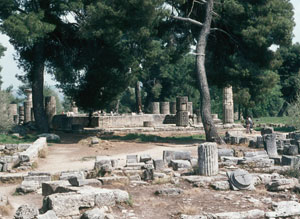 On the north side of the enclosure on the lower slopes of the Kronion were the Treasuries (left) built by various Greek cities over the centuries to house their dedications to the sanctuary. Although only ten are mentioned by Pausanias, the remains of twelve small buildings have been found. Just outside the northwest corner of the altis and right next to the Heraion was the Prytaneion which housed the offices of the officials of the sanctuary. It is known to have included a special room for the sacred hearth with its eternal flame and a banquet hall where Olympic victors were entertained. In the second century AD a wealthy Athenian named Herodes Atticus dedicated an exedra (fountain) to provide drinking water for visitors to the site. It was fed by an aqueduct which channelled water from a spring on the slopes of the Kronion.
On the north side of the enclosure on the lower slopes of the Kronion were the Treasuries (left) built by various Greek cities over the centuries to house their dedications to the sanctuary. Although only ten are mentioned by Pausanias, the remains of twelve small buildings have been found. Just outside the northwest corner of the altis and right next to the Heraion was the Prytaneion which housed the offices of the officials of the sanctuary. It is known to have included a special room for the sacred hearth with its eternal flame and a banquet hall where Olympic victors were entertained. In the second century AD a wealthy Athenian named Herodes Atticus dedicated an exedra (fountain) to provide drinking water for visitors to the site. It was fed by an aqueduct which channelled water from a spring on the slopes of the Kronion.
The Stadion
The venues for the competitions were located to the east of the altis, separated from it by the Echo Stoa, a long portico that offered shade to the visitor. A vaulted corridor led to the Stadion. Originally it was simply a flat piece of ground one stade long with the finish line at the Altar of Zeus within the altis. But in the middle of the fifth century BC it was 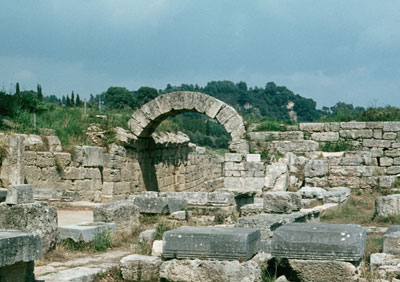 moved to the east, beyond the boundaries of the enclosure, and embankments were built to accommodate spectators. Most of them stood along the slopes but there was an area of seating midway along the southern side that was reserved for games officials.
moved to the east, beyond the boundaries of the enclosure, and embankments were built to accommodate spectators. Most of them stood along the slopes but there was an area of seating midway along the southern side that was reserved for games officials.
There is no consensus as to what the length of a stadion actually was— surviving tracks range anywhere from 180-24o metres long. The one at Olympia is over 212 metres. The Greek unit of measure based on it was said to be 600 ‘feet’ but foot size seems to have varied markedly from place to place.
The runners appear to have run in lanes, since mention is made of a series of 5 stakes that each runner passed. In addition to the short sprint, there was the diaulos or 2 stadia race, in which the runners turned at the far end of the track and raced back to the starting line. There is some debate as to whether they turned around individual stakes or a single post. A long-distance race, the dolichos, was run over a distance of nearly 5 kilometres. It started and finished at the stadion but route wound through the sanctuary.
The Hippodromos
The horse and chariot races took place in the hippodromos, which was located just south of and parallel to the stadion. According to one source, the eleventh century Tabula Heroniana II, the race course was about 780 metres long and 320 metres wide. There was a wall running the length of it, with turning points at either end. The ancient travel writer, Pausanias, describes an elaborate starting mechanism and embankments on either side but none of this is visible today. It was long believed that all trace of it had been obliterated in medieval times by the flooding of the Alphaos River but in 2008, German archaeologists using geomagnetic techniques claimed to have traced a good deal of it.
The Palaistra
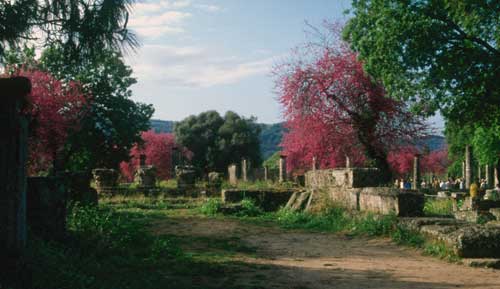
The Palaistra as seen from the Gymnasion at Olympia
 The rest of the athletic events— the wrestling, the boxing and the field sports such as the discus and javelin— took place to the west of the sanctuary. The Gymnasion and Palaistra were both built in the third century BC. The Palaistra was used as an exercise area for wrestlers, boxers and jumpers. It was a peristyle court (meaning it was surrounded by an internal colonnade forming shaded porticoes on all four sides) It was roughly square (66.35 x 66.75 metres) with a pair of entrances on the south side, one in each of the corners. These had small porches supported by pairs of Corinthian columns and led, by way of antechambers, to a long, shallow hall lined with benches and faced with Ionic columns— presumably the apodyterion (changing room). On the opposite side of the courtyard was the ephebion, a room where the competitors could relax and mingle.
The rest of the athletic events— the wrestling, the boxing and the field sports such as the discus and javelin— took place to the west of the sanctuary. The Gymnasion and Palaistra were both built in the third century BC. The Palaistra was used as an exercise area for wrestlers, boxers and jumpers. It was a peristyle court (meaning it was surrounded by an internal colonnade forming shaded porticoes on all four sides) It was roughly square (66.35 x 66.75 metres) with a pair of entrances on the south side, one in each of the corners. These had small porches supported by pairs of Corinthian columns and led, by way of antechambers, to a long, shallow hall lined with benches and faced with Ionic columns— presumably the apodyterion (changing room). On the opposite side of the courtyard was the ephebion, a room where the competitors could relax and mingle.
The Gymnasion
A doorway in the centre of the north wing of the Palaistra led to the Gymnasion, where the competitions took place. Other rooms were provided where the athletes would be rubbed with oil and scaped down with a bronze strigil— usually done by a friend— and for storage.
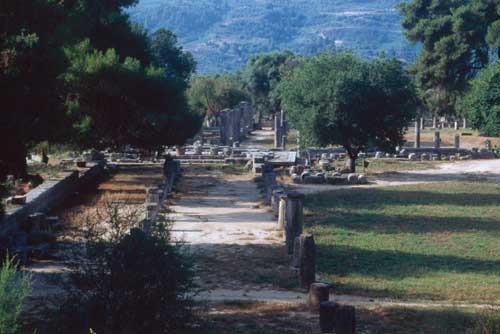
View of the Gymnasion at Olympia with the Palaistra in the background
The Gymnasion adjoined the Palaistra on the north side— a closed rectangular complex 120 x 220 metres. It had a large open court in the middle and was surrounded by stoas on all four sides. It provided plenty of space for practising with the discus or the javelin. Unfortunately, much of it was subsequently washed away by the flooding of the Kladeos River.
Other Buildings
To the south of the Palaistra was the Theokleon, which housed the priests, along with the ruins of Pheidias' workshop, later converted to a Christian church, where all sorts of broken tools, clay moulds and other objects associated with the project were found. The Leonideum was erected in the southwest corner of the complex to serve as a guest house for official visitors. It was named after the architect, Leonidas of Naxos, who also financed it. There were suites of rooms on all four sides which faced into a peristyle courtyard.
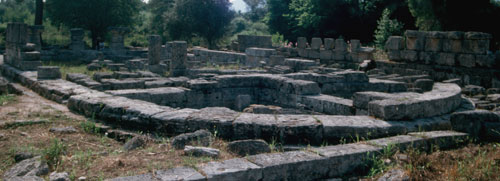
One of the apsidal (it has a semi-circular apse at one end) buildings of the Bouleuterion
Along the south side of the altis were the principal administrative buildings, including the Bouleuterion or Council House, which consisted of a pair of apsidal buildings linked by a long portico (stoa) with a square building in between. The latter contained the altar of Zeus Horkios (‘keeper of oaths’) upon which the athletes made their vows. In addition, there were baths and another long portico, the South Stoa, which marked the boundary of the altis.
The End of the Ancient Olympics
After the closure of the sanctuary by the edict of the emperor Theodosius in 393 AD, the buildings rapidly fell into decay. The colossal statue of Zeus was transported to Constantinople where it was subsequently destroyed in a fire. The site itself was rocked by a pair of tremendous earthquakes in the sixth century which destroyed virtually all of the remaining buildings. Only Pheidias's workshop survived and was converted into a Christian basilica. Later flooding of the Alphaos and Kladeos together with erosion of the Kronion hill eventually covered the site in a deposit of silt some seven metres thick. Excavation of the site began with a German expedition in 1875 and has continued to the present day.
